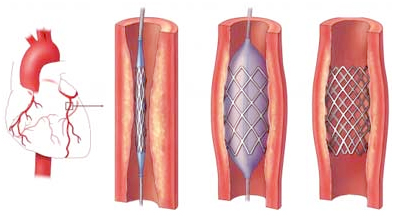Better stent surgery stats needed: heart doctors
Publicly reported statistics about how patients fare after a common heart procedure often are inaccurate, says a new study that suggests publishing the poor quality numbers may do more harm than good.
The proportion of patients who die within 30 days of a medical procedure is sometimes used to gauge the effectiveness of the treatment, or of the hospital or doctor administering it.
After analyzing thousands of patient records at one U.S. hospital, researchers found that less than half of the deaths following percutaneous coronary intervention (PCI) - also known as coronary angioplasty - were related to the procedure.
That’s far fewer than the number of deaths usually attributed to the surgery, which involves clearing a narrowed artery then inserting a mesh tube called a stent to prop the vessel open.
“I think what this really points out is that (with) the clinical complexity of medicine (it) can be tough to get a policy that’s sort of one size fits all,” said Dr. Karen Joynt, a cardiologist at Brigham and Women’s Hospital in Boston.
Joynt, who was not involved with the new study but has done similar research, said there are a number of factors that determine whether or not a person dies after PCI - many of them unrelated to the actual procedure.
Coronary angioplasty and stents
Coronary angioplasty and stents - British Heart FoundationStents are used during a coronary angioplasty operation. The operation helps to relieve blockages or narrowing of arteries.
Coronary angioplasty – or PCI and PTCA – is a technique for treating coronary heart disease and angina.
It helps improve your blood supply to the heart muscle and can help to relieve angina symptoms. You might also have angioplasty if you’ve already had a coronary bypass but your angina has returned.
You’ll usually have an angiogram before your angioplasty, but sometimes this is carried out at the same time. Angioplasty is sometimes used as an emergency treatment for people that have had a heart attack or unstable angina (angina that comes on with less and less physical activity or even while you are resting).

About 500,000 angioplasties are performed in the U.S. every year. It’s often used in emergency situations, for instance to stop heart attacks caused by blocked blood vessels.
New York State first reported the number of people who died after PCI in its hospitals in 1991. Since then, Massachusetts and Pennsylvania started to report that figure as well.
According to the new study’s authors, the U.S. Centers for Medicare and Medicaid Services have also proposed using the number as a quality measure, in the hope of improving patient care.
For the new study, researchers led by the Cleveland Clinic’s Dr. Mehdi Shishehbor used patients’ medical records to see whether deaths following PCI could be blamed on the procedure.
Out of 4,078 PCIs performed between January 2009 and April 2011 at one U.S. hospital, they found 81 deaths within 30 days of the surgery, representing 2 percent of patients who had the procedure.
Forty-seven, or about 60 percent, of those 81 patients died of a heart-related problem, but only 34, or 42 percent, of the deaths resulted from a complication of the procedure itself.
Previous research has attributed up to 60 percent of deaths following PCI to the procedure, but those figures were often based on causes of death listed on death certificates, which are frequently inaccurate, according to Shishehbor and his colleagues.
In the current study, based on close reading of every patient’s chart, many of the deaths were among patients who were very sick when they got to the hospital and might have died with or without PCI, the researchers report in the Journal of the American College of Cardiology.
Fifty eight percent of the patients who died arrived in cardiac arrest, cardiogenic shock or with the most lethal type of heart attack, the authors point out.